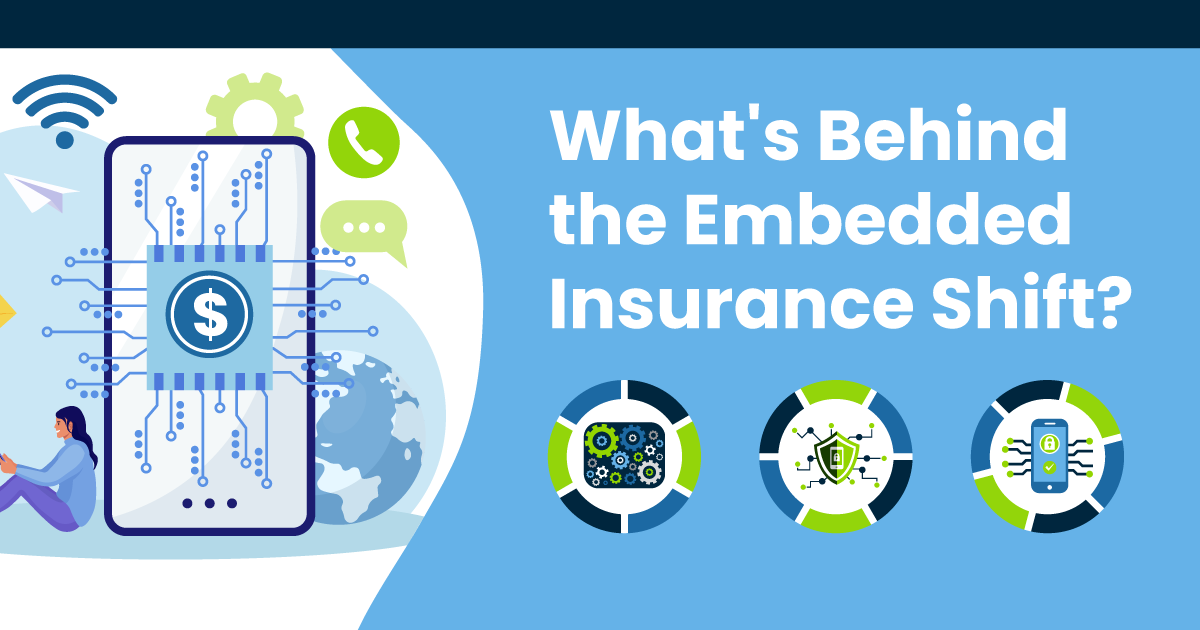
What’s Behind the Embedded Insurance Shift?
Embedded insurance has taken off. According to Conning, Inc.1, embedded insurance premiums could exceed $70 billion by 2030. Embedded insurance growth is part of a larger transformation that’s spurring a fundamental shift in the nature of insurance. If traditional carriers want a piece of this pie, they need to learn why and how to leverage embedded insurance.
From Reactive to Preventative
The rise of embedded insurance represents more than just a major shift in insurance distribution; it also hints at a fundamental change in the nature of insurance.
Historically, insurance purchases have been an afterthought for consumers – something they needed to protect against financial loss but hoped never to use. This is changing. As Property Casualty 3602 explains, “AI is a revolution in risk avoidance” and “preventative measures are the future of insurance.”
Embedded insurance is part of this revolution. It often goes hand in hand with other developments, such as connectivity and AI. With embedded insurance, coverage doesn’t have to be an afterthought and something you hope never to use. Instead, it can be part of the overall experience of buying a product or service.
One of the easiest places to see embedded insurance in action is in the auto insurance sector. As cars become increasingly connected, they’re producing a wealth of data that can power telematics insurance programs. As a result, car manufacturers have been entering the insurance market. For example, GM has developed an insurance platform that uses its subsidiary OnStar to help set rates based on driving habits.3 Tesla is another notable example. Property Casualty 3604 says Tesla Insurance uses a safety score based on five factors, and drivers can lower their premiums by raising their safety scores.
Collaborate or Be Replaced
Majesco5 says “Insurers have an opportunity to develop and utilize a broader distribution ecosystem that engages customers when and how they want…putting the customer first.” However, they may not be able to compete on their own. To create ecosystems of interconnected channels, collaboration is necessary.
The insurers that fail to collaborate today could be replaced tomorrow.
According to McKinsey6, embedded telematics is one of three technologies that will shape the future of mobility and global auto insurance. (The other two are autonomous driving and vehicle electrification.) With the development of connected cars and embedded telematics, car manufacturers can provide more products and services, including insurance. Over the coming year, they may become major players in insurance.
As OEMs enter insurance, traditional carriers have the chance to partner with them to provide insurance products. If they don’t, OEMs may simply replace traditional carriers. This is already starting to happen. Investopedia3 says GM and Tesla are offering their own insurance policies, whereas Ford has opted to partner with Allstate to offer insurance.
The Barriers Ahead
Embedded insurance distribution represents real change, which is never easy. Before embedded insurance can reach its full potential, insurers will need to overcome several barriers.
Insurers need to know:
What consumers want. Embedded insurance makes buying insurance easy, but convenient options only hold appeal if they’re what people want. Insurance companies need to assess consumer needs to determine which options will appeal to consumers, when to offer these options, and which price points will convince consumers to buy coverage.
How to navigate regulations. Regulatory compliance will undoubtably be a factor during the rollout of embedded insurance. As Property Casualty 3607 explains, some of the most essential regulations involve state insurance producer licensing requirements. Under state laws, a company that wants to sell embedded insurance may need to obtain licensing, which may involve naming an actual person (not just the company) as the responsible licensed producer in charge of compliance. When companies sell embedded insurance in multiple states, the licensing requirements can become more complicated. On top of this, companies offering embedded insurance may also need to comply with state regulations regarding the coverage itself.
How to leverage their data. To streamline underwriting and claims processing, insurers need data. Moreover, data needs to be reliable. Although insurers have access to large quantities of data, some of it may be outdated, incomplete, inaccurate, or otherwise “dirty.” In a LexisNexis8 survey, 60% of respondents said telematics apps yield incomplete and limited data, which makes insurers less confident about their capability to assess risks based on the data. Before insurers can leverage data to its full potential, they need to achieve next-level data strategy maturation.
Embedded insurance is just one part of the insurance industry’s ongoing digital transformation. Stay tuned for our next article to learn more about the Embedded Insurance Trajectory. And in the meantime, explore modern digital payment options with One Inc. Learn more.
Sources:
- Conning Inc - https://www.prnewswire.com/news-releases/embedded-insurance-distribution-could-exceed-70-billion-in-premium-in-the-us-by-2030-301718454.html
- Property Casualty 360 - https://www.propertycasualty360.com/2022/01/13/preventive-measures-are-the-future-of-insurance/
- Investopedia - https://www.investopedia.com/general-motors-enters-the-auto-insurance-industry-5089024
- Property Casualty 360 - https://www.propertycasualty360.com/2022/05/19/tesla-says-it-can-lower-insurance-costs-make-driving-safer/
- Majesco - https://www.majesco.com/white-papers/expanding-channels-for-insurance-a-spectrum-from-traditional-to-affinity-and-embedded/
- McKinsey - https://www.mckinsey.com/industries/financial-services/our-insights/connected-revolution-the-future-of-us-auto-insurance
- Property Casualty 360 - https://www.propertycasualty360.com/2022/07/07/looking-to-embed-insurance-on-your-website-know-these-licensing-rules-first-414-224303/
- LexisNexis - https://risk.lexisnexis.com/insights-resources/white-paper/2022-auto-insurance-trends-report?trmid=INSATO22.Auto_Trend.RprtLnks.OMXX-633603
Tags: Technology & Innovation
Written by The One Inc Content Team
Want to read more articles like this?

